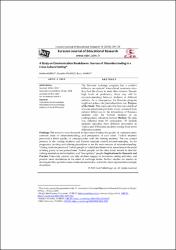| dc.contributor.author | Korkut, Perihan | |
| dc.contributor.author | Dolmacı, Mustafa | |
| dc.contributor.author | Karaca, Burcu | |
| dc.date.accessioned | 2020-11-20T14:50:41Z | |
| dc.date.available | 2020-11-20T14:50:41Z | |
| dc.date.issued | 2018 | |
| dc.identifier.issn | 1302-597X | |
| dc.identifier.uri | https://doi.org/10.14689/ejer.2018.78.7 | |
| dc.identifier.uri | https://app.trdizin.gov.tr//makale/TWprMk5EWXhNUT09 | |
| dc.identifier.uri | https://hdl.handle.net/20.500.12809/1596 | |
| dc.description | WOS: 000451637300007 | en_US |
| dc.description.abstract | The Erasmus exchange program has a positive influence on students' intercultural awareness since they find the chance to meet other cultures. Despite high levels of proficiency, there may still be misunderstandings between students of different cultures. As a consequence, the Erasmus program might not achieve its pluriculturalism aim. Purpose of the Study: This study aimed to find out what kind of communicational problems -if any- stemmed from cultural differences in the interactions of Erasmus students with the Turkish students in an undergraduate education context. Method: The data was collected from 69 participants: 39 Turkish students attending three different universities in Turkey and 30 Erasmus students coming from seven different countries. Findings: The answers were clustered in three main themes; the quality of communication; common areas of misunderstanding; and perceptions of each other. Turkish students perceived a better quality of communication with the visiting students. The eye contact patterns of the visiting students and Turkish students caused misunderstanding. As for pragmatics, inviting and offering procedures w ere the main sources of misunderstanding. Visiting students perceived Turkish people as helpful and benevolent, sometimes to the point of being pushy or too protectionist. Turkish people, on the other hand, tended to describe visiting students as individualistic and "free-spirited" people. Implications for Research and Practice: University courses can help students engage in awareness raising activities, and provide more orientation at the onset of exchange terms. Further studies are needed to investigate other potential areas of miscommunication, and with a more representative sample of cultures. (c) 2018 Ani Publishing Ltd. All rights reserved | en_US |
| dc.item-language.iso | eng | en_US |
| dc.publisher | Ani Yayincilik | en_US |
| dc.item-rights | info:eu-repo/semantics/openAccess | en_US |
| dc.subject | Intercultural Communication | en_US |
| dc.subject | Miscommunication | en_US |
| dc.subject | Exchange Students | en_US |
| dc.subject | Cultural Differences | en_US |
| dc.title | A Study on Communication Breakdowns: Sources of Misunderstanding in a Cross-Cultural Setting | en_US |
| dc.item-type | article | en_US |
| dc.contributor.department | MÜ, Eğitim Fakültesi, Yabancı Diller Eğitimi Bölümü | en_US |
| dc.contributor.institutionauthor | Korkut, Perihan | |
| dc.identifier.doi | 10.14689/ejer.2018.78.7 | |
| dc.identifier.issue | 78 | en_US |
| dc.identifier.startpage | 139 | en_US |
| dc.identifier.endpage | 158 | en_US |
| dc.relation.journal | Eurasian Journal of Educational Research | en_US |
| dc.relation.publicationcategory | Makale - Uluslararası Hakemli Dergi - Kurum Öğretim Elemanı | en_US |


















